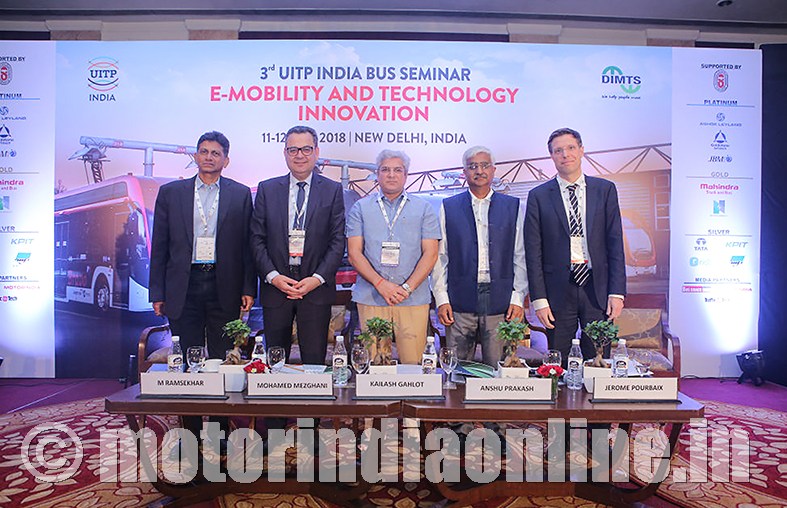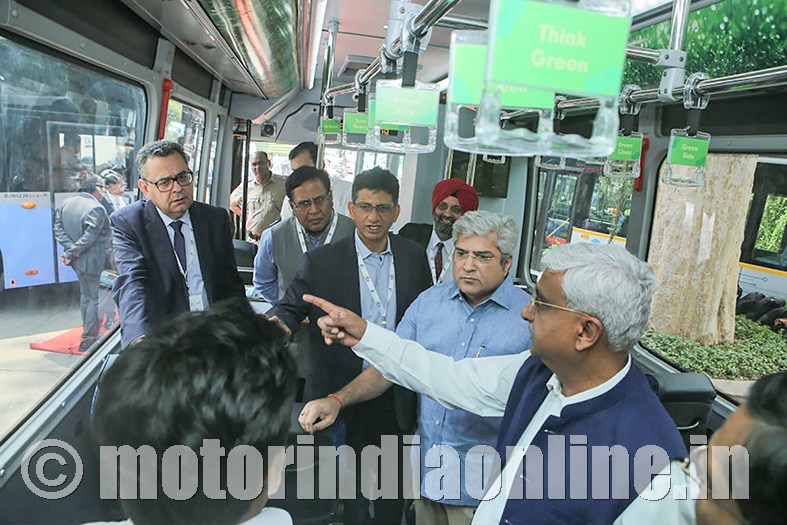The international seminar held on May 11-12 at New Delhi saw various stakeholders and transportation experts discussing in detail the Indian bus industry’s roadmap to e-mobility and the role of technology innovation in building sustainable bus transport systems for cities.

How disappointing it is that any pictorial or graphic illustration of urban air pollution in our cities featured in newspapers and visual media purportedly show rancid exhaust smoke belching from State-owned city buses. An image that helps reinforce a perception that buses are an integral part of air-quality problem and hence warrant some zero-emission technology as messiah to offset the emission from bus transportation, rather than considering it as a solution capable of taking a large number of polluting cars off the city streets. A distorted understanding of the reality, indeed.
In fact, true to its ‘public transport’ credentials, buses are the real people movers in India, serving the masses in cities and towns. With the predictions that the urban population in the country is likely to grow to about 473 million in 2021 and 820 million by 2051 from 285 million in 2001, there is a greater need for efficient and sustainable public transport systems, especially buses. Unlike other urban transit networks like metro rail, buses can be cost-effective and more pragmatic for the immediate future, requiring less investments and restructuring of infrastructure.
While improved investments and partnerships among various stakeholders are needed to promote bus transport, buses have to pass the ‘test of fire’ with the help of growing technologies to be emission free, fuel efficient and as sustainable as possible. E-mobility is a step in that direction, although it is not the only means to achieve the aspired end, the others being use of cleaner fuels, hybrid technologies, etc. Moreover, the procedural and operational inefficiencies in traditional bus transportation must be won over, by leveraging the endless possibilities offered by ICT and IoT in the digital age.

Advancing bus transport with E-mobility
“Transport is an important parameter in urban infrastructure that is critical for growth and economic development of cities”, said Mr. Anshu Prakash, Chief Secretary, Government of NCT of Delhi, while noting that bus transport holds a great place in the government’s imagination on sustainable mobility and smart cities. There can be no debate on the necessity of e-mobility, he said, but the imperative now is on how to incorporate it in everyday mobility.
Should e-mobility center on transformative luxury of buses or affordability for the masses? Here Mr. Kailash Gahlot, Minister of Transport, Government of NCT of Delhi, pointed out the issue of upfront cost of e-buses that may ultimately affect the common man’s wallet. “Delhi boasts one of the well-established bus transport coverage in the country. Yet, the current status is no match for the requirement of 11,000 buses to cater to the considerable needs of the people”.
He affirmed that his Government is committed to making bus transport cleaner and sustainable in the city, including plans to procure 1,000 CNG and 1,000 electric buses on its own, and 40 e-buses in the second phase of the FAME scheme.
While acknowledging that a huge amount of preparation and calibration in the ways of business is required before shifting to e-buses, Mr. M. Ramsekhar, MD and CEO of DIMTS Ltd., suggested that a ‘concessionaire model’ that binds the manufacturer and the operator can be cost-effective and beneficial for STUs in adopting electric buses. He added that the procurement should be technology agnostic, thereby striking the right cord in choosing what serves the best for the particular demands of the operators.
Global case studies
The seminar drew experiences and analyse from global e-bus movements in search of apt electric solution for urban bus networks in Indian cities. Paul Bromley of Phoenix Business Consulting delineated key learnings from the Chinese experiences in embracing e-buses in masses, where over 90,000 electric buses were sold in 2017, pushing the total e-bus fleet to 316,000 – a whopping 92% of the global fleet. The city of Shenzhen, in particular, boasts a full electric fleet of 16,359 e-buses with 510 charging stations and a total of over 8,000 charging points.
In the Shenzhen trail experience, the battery is borne by the supplier with an 8-year warranty and a sub-contractor is responsible for infrastructure. Battery charging is sub-contracted too, but is charged back at 0.10$ which is a lot lower diesel cost. Mr. Bromley pointed out that the major barriers for EV adoption are availability of charging infrastructure and limited driving range.
Hong Kong follows a slightly different approach as compared to China wherein the Government has provided subsidy to 36 electric buses to be operated over a two-year period on a trial basis. Charging infrastructure issues left up to the operator and the OEM to resolve. Vehicles are operated as orphans, and perceived reliability has been an issue as well as the inability to operate full days.
The experiences from pilot to roll-out of electric buses in Finland and Sweden were shared by Mr. Pihlatie Mikko, Project Manager, VTT Finland. It is found that, before moving into a roll-out of the commercial services, a city-specific statistical analysis and optimization of fleets, operational scenarios are highly recommended. Especially with the existing technological advancements, planning of potential bus network locating and dimensioning the charging nodes can be done using digital map data and other open source tools.
For instance, a system level analysis at Santiago De Chile found that several important and unknown parameters have an impact on the TCO like availability and reliability of vehicles, chargers (in both depot and opportunity cases), load variation and corresponding energy consumption, energy costs and power tariffs, grid stability, connection costs and battery sizes.
In India, the Department of Heavy Industry supports both supply (bus procurement) and hiring (gross cost contract) model by way of capital subsidy for electric buses (up to 60% of cost restricted to 1 crore, whichever is lower). However, it has been observed that the hiring model (240 buses) was more favoured over the supply model (150 buses) so far.
Experts opined that priority is given to the vehicles being deployed for multimodal public-transport. “With large-scale deployment of electric buses, the hiring rates will improve further”, said Ankit Sanghvi, President, Electric Mobility Alliance (EMA).
Preference should be given to technology which allows interoperable charging infrastructure across different OEM products. Linking incentive to bus length and charging infrastructure cost would help cities prioritize their requirement and also allow the operators to plan for optimal solutions like fast chargers, agreed the speakers at the seminar.
Technology innovation for bus transport
With digitization and connected services taking up every sector, the public transport needs to embrace it, to leverage numerous opportunities offered as well as preparing itself for its role in the future mobility market. This includes involving personal mobile technologies in ticketing, journey planning and inter-modality. Further, the city should adopt open data policy and mobility as a service (MaaS) to increase acceptability of public transport. “The vision here is not just electric mobility, but ‘connected, shared, and transformative mobility’ that is sustainable, including autonomous driving”, noted Mr. Sajid Mubashir, Scientist, Department of Science and Technology.
Guido Di Pasquale, Senior Manager, UITP Brussels, elaborated on the Maas concept, an integrated mobility platform that bridges the gap between the operator and the user. This involves five different levels of integration – no integration, integration for information (multimodal travel planner, price info), integration for payment (single trip – find, book and pay), integration of service offer (bundling / subscription), and policy integration (Governance and PP – Cooperation). “Public transport, especially buses, will act as the backbone of integrated urban mobility”, he observed.
As far as digital fare collection is concerned, apart from contact and contactless cards, there are other alternatives like mobile payments and wearable devices that can promote easier digital ticketing system.
Speaking about the mobile ticketing, Mr. Brijraj Vaghani, CEO, Ridlr, cited some important statistics about growing mobile market and the need to take advantage of the existing smart technology to improve ticketing services.
Ridlr has designed a solution that utilizes this opportunity to promote mobile ticketing. Essentially an ETIM-based local Wi-Fi ticketing app, it provides for hassle-free payment mode for the users while ensuring data securing and processing by operators. Ancillary services like plan-my-travel and real-time traffic updates to users, easy reconciliation process and live dashboard with data analytics options for are also on offer.
